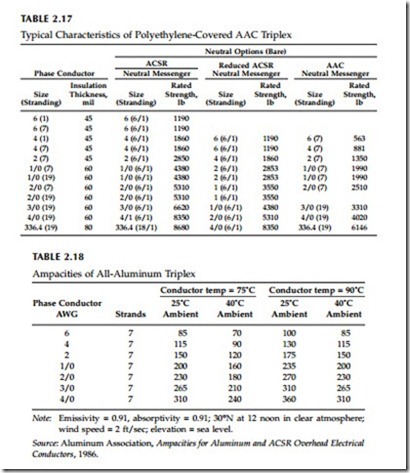Secondaries
Utilities most commonly install triplex secondaries for overhead service to single-phase customers, where two insulated phase conductors are wrapped around the neutral. The neutral supports the weight of the conductors. Phase conductors are normally all-aluminum, and the neutral is all-aluminum, aluminum-alloy, or ACSR, depending on strength needs. Insulation is normally polyethylene, high-molecular weight polyethylene, or cross-linked polyethylene with thickness ranging from 30 to 80 mils (1.1 to 2 mm) rated for 600 V. Similarly for three-phase customers, quadraplex has three insulated phase conductors wrapped around a bare neutral. Table 2.17 shows characteristics of polyethylene triplex with an AAC neutral.
Triplex secondary ampacities depend on the temperature capability of the insulation. Polyethylene can operate up to 75°C. Cross-linked polyethylene and EPR can operate higher, up to 90°C. Table 2.18 shows ampacities for triplex when operated to each of these maximum temperatures. Quadraplex has ampacities that are 10 to 15% less than triplex of the same size conductor. Ampacities for open-wire secondary are the same as that for bare primary conductors.
Table 2.19 shows impedances of triplex. Two impedances are given: one for the 120-V loop and another for a 240-V loop. The 240-V loop impedance is the impedance to current flowing down one hot conductor and returning on the other. The 120-V loop impedance is the impedance to current down one hot conductor and returning in the neutral (and assuming no current returns through the earth). If the phase conductor and the neutral conductor are the same size, these impedances are the same. With a reduced neutral, the 120-V loop impedance is higher. Table 2.19 shows impedances for the reduced neutral size given; for a fully-rated neutral, use the 240-V impedance for the 120-V impedance.
Source: Aluminum Association, Ampacities for Aluminum and ACSR Overhead Electrical Conductors, 1986.
